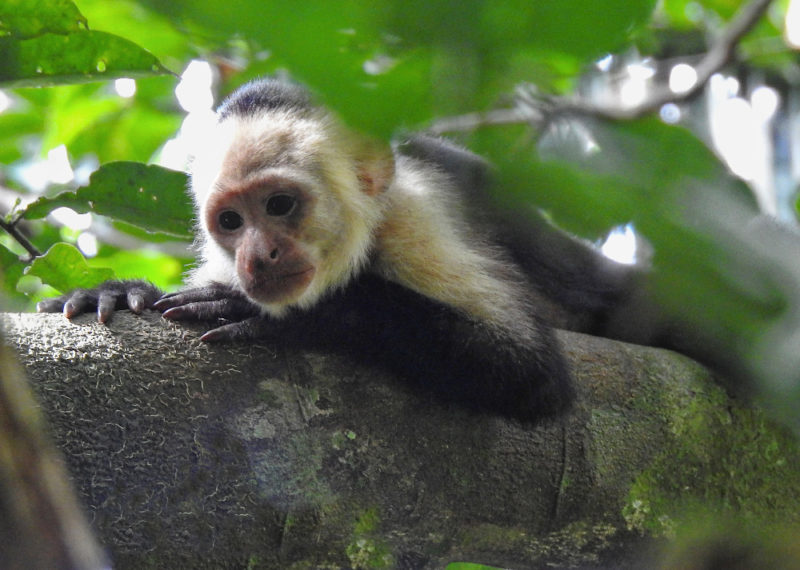Hidden in dense forests, tucked away on quiet beaches, and nestled beneath lofty mountains, the rainbow tapestry that is Costa Rican wildlife is woven. The sheer amount of animal life that can be found in the country is staggering. With more than 500,000 unique species contained in an area far smaller than the average U.S. state, Costa Rica has become world-famous for its many creatures from the cuddly to the carnivorous.
With biodiversity like this, it’s a given that countless travelers make the pilgrimage to try their hands at spotting Costa Rican wildlife; it’s one of the most popular tourist activities in the country. The immense number of species in Costa Rica is a double-edged sword for the zoologically-inclined, though. Which animals should you focus on? Where are the best spots for seeing Costa Rican wildlife? The decision paralysis gets real.
Worry not, aspiring explorers. As always, we’ve got your back. In this guide, we’ll go over 11 of Costa Rica’s most iconic and interesting species to give you a taste of the variety that is found in the country. We’ll also go over where you’ll have the best shot of seeing each animal – and how realistic your chances of seeing it even are. Here’s our beginner’s guide to spotting Costa Rican wildlife.
Coatimundi
What is the coatimundi?
It’s not a lemur. It’s not a squirrel. And no, it’s not a tiny bear. So… what is it? One of Costa Rica’s cutest resident mammals, the coatimundi (also known simply as a coati) is part of Procyonidae, the raccoon family. Their distinctive features include their long, thick tails and their extended, white noses. Although other mammals may get more attention internationally, the coatimundi enjoys plenty of love in Costa Rica thanks to its adorable appearance and docile nature.
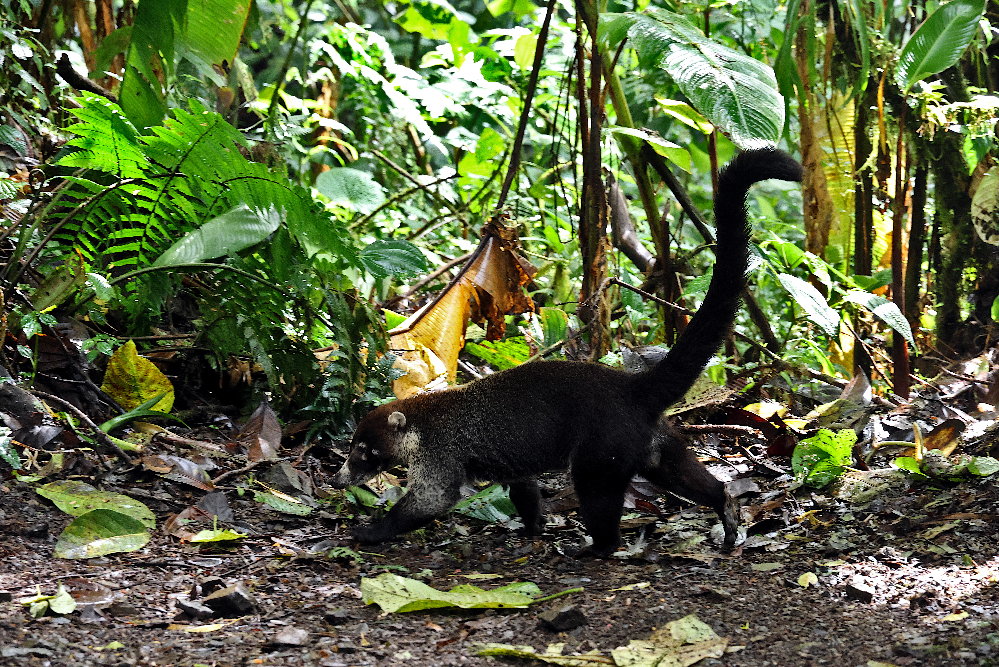
Where can you find the coatimundi?
Coatis can be found all over Costa Rica. While they are more frequently found in their natural habitats of forests and wetlands, they aren’t particularly picky about where they live. Seriously, you can go for a walk in the right neighborhoods of San José and see coatimundis scurrying around. However, your best chance of seeing them may be with a visit to Manuel Antonio National Park or the Arenal Volcano area.
How rare is the coatimundi?
The coatimundi isn’t rare at all; in fact, there’s a solid chance that you see it without even trying to. It’s one of the more common mammals in Costa Rica, but a coati sighting is always a joy!
Toucan
What is the toucan?
A flash of flamboyant color in the trees, the toucan is one of the most easily recognizable birds in Costa Rica. There are actually six different species of toucan that live in the country – all with unique coloring – but they all share the claim to fame of having massive, colorful beaks. As one of the most iconic Costa Rican wildlife species, the toucan is often high on the to-see list of both veteran birders and casual tourists.
Where can you find the toucan?
The short answer: it depends. Since there are six different species that each live in distinct regions, the best location will depend on what variety of toucan you want to see. In general, you should focus on rainforest areas. The forests around La Fortuna are particularly well-populated. No matter where you end up searching for toucans, keep your eyes on the trees – and, since toucans typically travel in groups, you’ll have a good chance at spotting others if you see one fly by.
How rare is the toucan?
Once again, it depends. Two of the species, the yellow-throated toucan and fiery-billed aracari, are relatively common, and your odds of seeing (or at least hearing) them are quite high if you visit an area like La Fortuna. Other species, like the yellow-eared toucanet, are a very rare sight. Pick your battles if your goal is to see a toucan on your Costa Rican wildlife trip!
Capuchin monkey
What is the capuchin monkey?
The capuchin, also known as the white-faced monkey, is one of the most lovable primates in Central America. With prehensile tails, playful behavior and expressive faces, it’s hard to deny their charm. The capuchin is more than just a pretty face, though – it’s one of the most intelligent monkey species in the world, with a brain-to-body ratio rivaled only by (you guessed it!) humans. The use of tools is just one example of the impressive mental capacity of capuchins.
Where can you find the capuchin monkey?
Capuchins abound in the lowland forests of Costa Rica, with Manuel Antonio National Park being one of the most likely spots to see them (other national parks, like Tortuguero and Palo Verde). This is largely because the monkeys there have become habituated to humans, so they don’t hide from the visiting tourists. In fact, the opposite is true: they seek out humans to try and steal snacks away. Cheeky little monkeys, aren’t they? To see capuchins behaving in a more natural way, you’ll need to get off the beaten path a bit more and head into more remote areas.
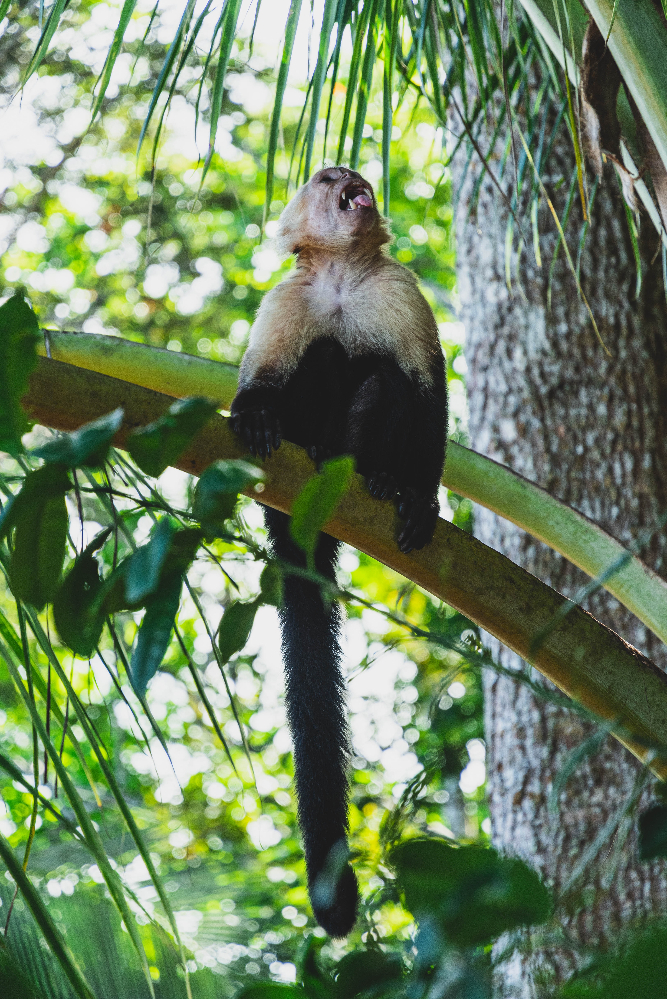
How rare is the capuchin monkey?
Costa Rica is home to four monkey species, and the capuchin is one of the most common. If you visit the parks of Costa Rica, there’s a high chance of spotting one.
Macaw
What is the macaw?
Another one of Costa Rica’s most beautiful birds, the macaw is a parrot with strikingly vibrant plumage and a loud, reverberating call. There are two species in Costa Rica: the great green macaw and the scarlet macaw. As implied by their respective names, you can distinguish between these two birds by their colors. Both are social and can live up to 50 years in the wild, believe it or not. Macaw numbers are dwindling in Costa Rica due in part to a variety of environmental factors, but conservation groups have begun taking steps to help local macaw populations.
Where can you find the macaw?
The scarlet macaw and great green macaw live in two very different regions. Most travelers will likely want to see the scarlet macaw, as it has the more iconic and immediately recognizable plumage. If that’s the case, you’ll want to head to Costa Rica’s Pacific coast. Carara National Park is a great spot, as it is both easily accessible and home to one of the largest populations of scarlet macaws in the country. The great green macaw, on the other hand, is only found on the Caribbean slopes in areas like the forests near Tortuguero.
How rare is the macaw?
Both species are relatively rare, but the great green macaw has a much smaller population. While conservation efforts will likely bring up the numbers of both in the coming years, finding the scarlet macaw is a safer bet for the time being.
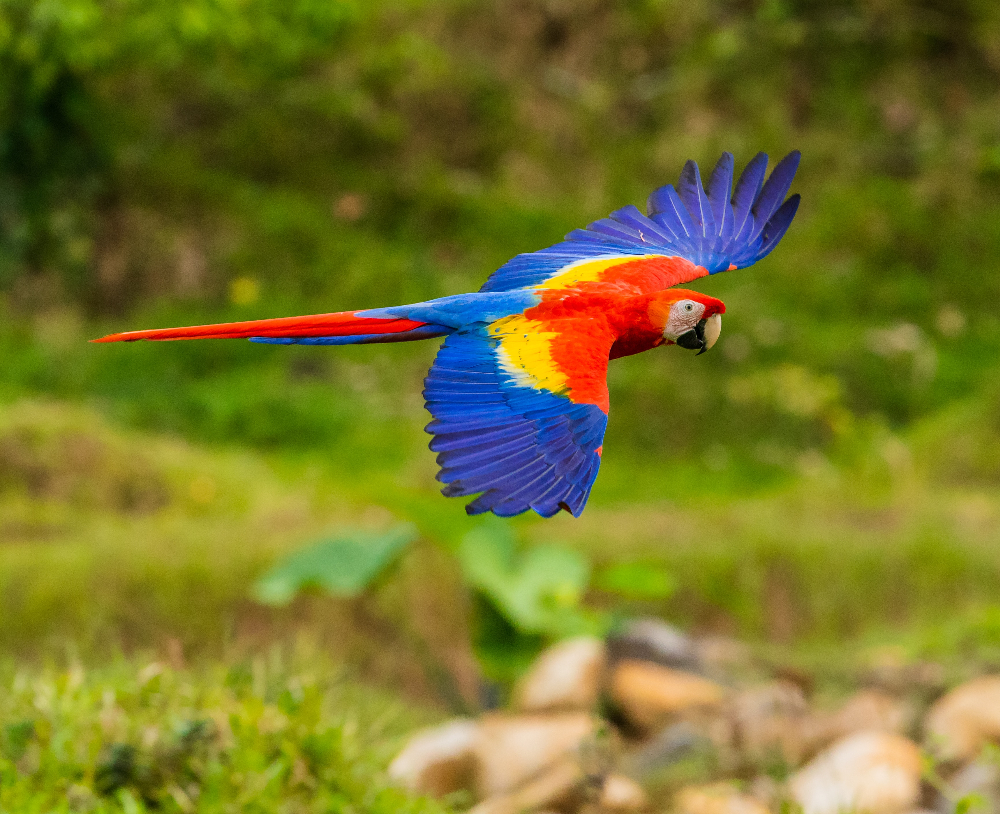
Three-toed sloth
What is the three-toed sloth?
The three-toed sloth is one of the most beloved mammals in Costa Rica, and it’s easy to see why. Their smiling faces, lazy lifestyles, and friendly demeanors have made them an absolute favorite of many travelers. Beyond their cuteness, though, three-toed sloths (and their other Costa Rica cousin, the two-toed sloth) are downright fascinating. They spend the majority of their lives in the trees, and their uniquely slow digestion means that they can take days or weeks to digest a single meal. Oh, and they can sleep as much as 20 hours a day. The jealousy is a little too real….
Where can you find the three-toed sloth?
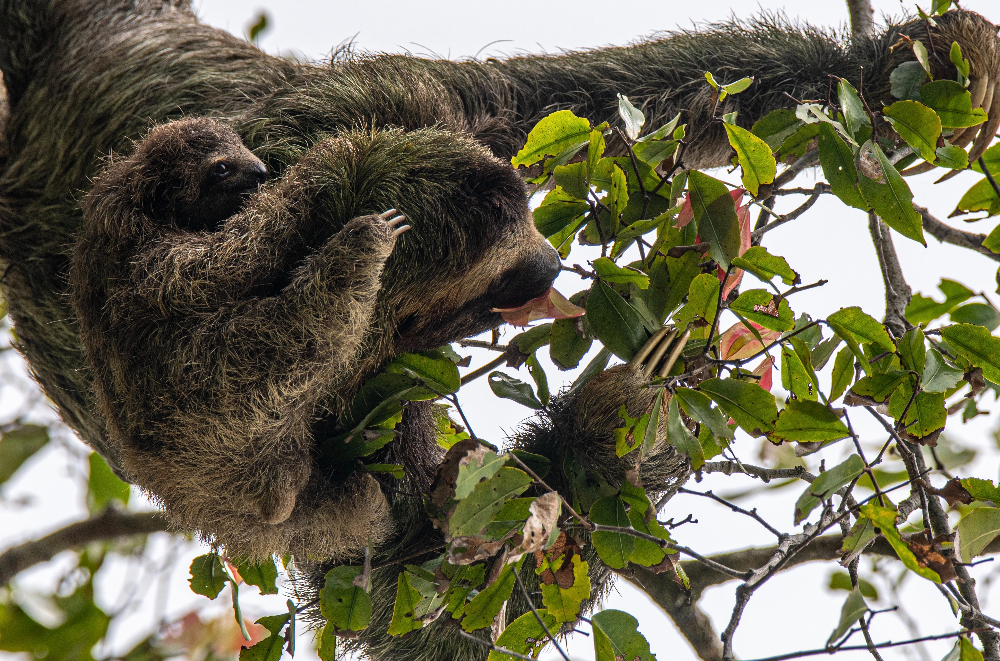
Like many of the more common species of Costa Rican wildlife, the three-toed sloth can be found in many areas around the country. The protected nature of national parks allows sloths to flourish there, so Corcovado, Manuel Antonio, and Tortuguero are good choices. The forests that surround the Arenal Volcano and Monteverde Cloud Forest are also popular sloth-spotting zones. Finally, if you want a more guaranteed chance, you can visit a wildlife protection group like the Sloth Sanctuary of Costa Rica or the Costa Rican Animal Rescue Center.
How rare is the three-toed sloth?
Costa Rica is home to two sloth species, with the three-toed sloth being the more common between the two. They are plentiful in the country, but they can be a rare sight due to the fact that they are, uh, slow. (Hence the name.) A sighting can be rare unless you have your eyes focused on the trees and are very attentive; it’s basically impossible for a sloth to just walk across the path or dart in front of you. If you’re set on seeing one, going with a local guide can help your odds. If you can’t get a guide, a pair of binoculars will serve you well.
Margay
What is the margay?
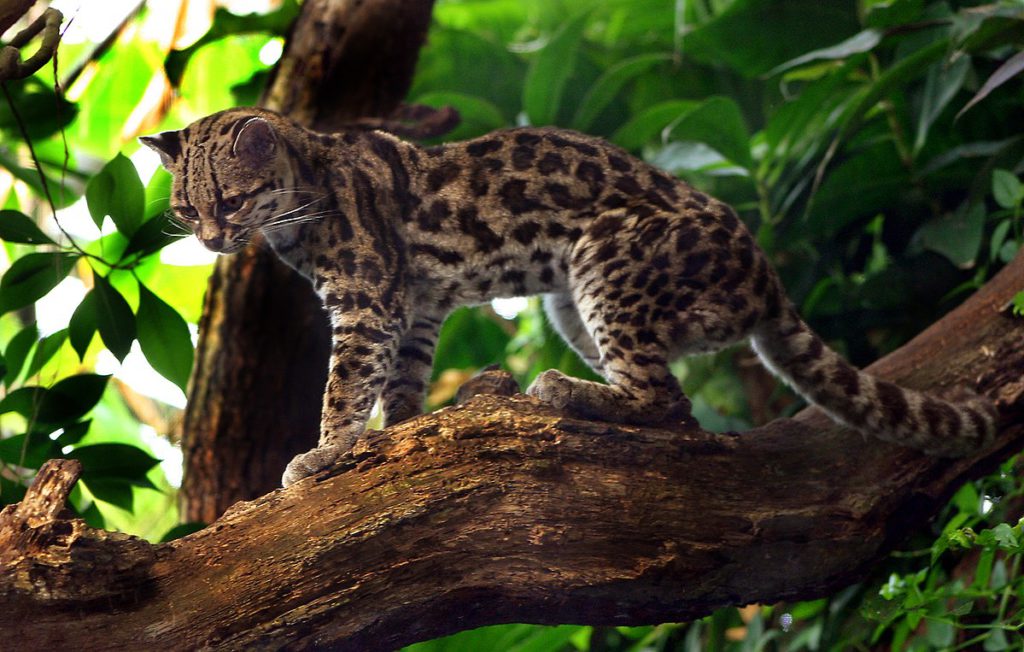
When most think of Costa Rican wildlife, it is monkeys, birds, and insects that come to mind. But there’s a more ferocious side to the fauna of the country – dangerous beasts that lurk in the forest. Okay, maybe ferocious and dangerous aren’t the most correct adjectives when it comes to the margay… but if it was bigger, it would be pretty intimidating! Equal parts savage and adorable, the house cat-sized margay is one of the smallest wildcats in Costa Rica. They boast big eyes perfect for their nocturnal lifestyle, stunning pelts, and an absolutely dexterous tree climbing ability.
Where can you find the margay?
Wherever there are forests, the margay can be found. Elevation hardly matters, as their range stretches from 0 to 10,000 feet above sea level, and they can be seen in rainforests, cloud forests, and tropical dry forests. It’s thought that margays prefer rainforests, though, so you’ll likely have the best luck there. As is the case for many Costa Rican animals, Corcovado National Park is a great place to see the margay, as well as Santa Rosa National Park and La Selva Biological Station.
How rare is the margay?
The margay is no longer as rare as it once was. Unregulated hunting caused the margay’s numbers to drop, but recent protective efforts have allowed margay populations to bounce back once more. However, margays are nocturnal, and that ultimately means that a sighting is pretty rare. Booking a night tour with an experienced guide is a smart move for anyone who wants to see the margay in the wild.
Spider monkey
What is the spider monkey?
The spider monkey is one of four Costa Rican monkey species, and it may have the most unique appearance of all of them. Long, skinny limbs, an inquisitive expression, and a trademark prehensile tail that can support its entire body weight all contribute to the spider monkey’s characteristic image. The spider monkey is also incredibly social, often living in groups of up to 40 monkeys.
Where can you find the spider monkey?
Spider monkeys can be seen all around Costa Rica. As you might expect, the wildlife-rich national parks are solid choices (Costa Rica’s national parks, much like Brazil’s, are always worth a visit), but the forests that sprout from the riverbanks of Caño Negro Wildlife Refuge are another great pick if you’re looking for a bit more solitude. Even a walk in a town like Jacó provides the opportunity to see these quick, playful monkeys moving through the forest canopy.
How rare is the spider monkey?
Although deforestation has harmed the spider monkey in Costa Rica, they remain a relatively easy sighting. Visiting a park or wildlife area gives you a very good chance of seeing one; booking a wildlife tour raises that to a nearly 100% chance in many spots.
Quetzal
What is the quetzal?
Costa Rica is home to plenty of colorful birds, but the quetzal may just be the most glorious. Thought to have a connection to the legendary deity Quetzalcoatl, the quetzal is known for its amazing iridescent plumage that seems to glow in the sunlight. They are small birds, but their unusually long tail feathers give them a graceful, larger-than-life appearance. Although it is the national animal of Guatemala, the quetzal holds a lot of significance in Costa Rica as well.
Where can you find the quetzal?
Two words: cloud forest. This is the main environment where the beautiful quetzal can be seen. Luckily for Costa Rican wildlife enthusiasts, the country is home to many incredible cloud forests that are more than worth a trip. Monteverde Cloud Forest Reserve is one of the more popular areas to quest for quetzals, but that popularity also means that the trails are crowded and the birds may be a bit more wary to show themselves. Heading to San Gerardo de Dota will allow you to ditch the throngs of people, and the aptly-named (and moderately remote) Los Quetzales National Park is also home to a population of these iconic avians.
How rare is the quetzal?
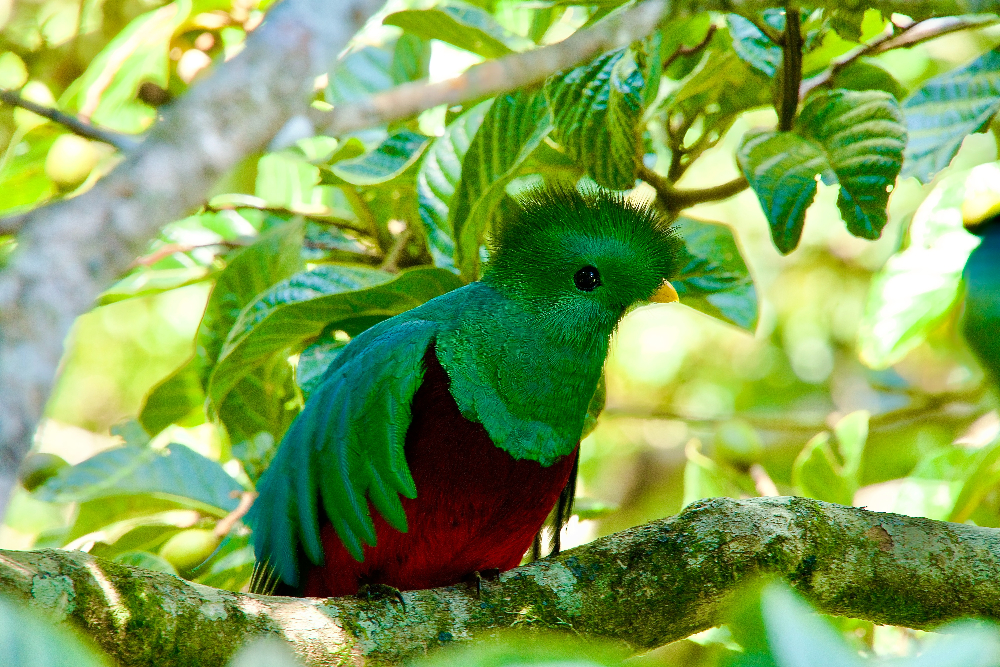
Birding is never a guarantee, and that’s doubly true when it comes to a small, elusive, endangered bird like the quetzal. Many birders are able to see the quetzal, though, by paying a visit to the Costa Rican cloud forest between February and July. In other words: yes, the quetzal is rare, but don’t let that deter you from attempting to see this amazing creature.
Tapir
What is the tapir?
The tapir (or the Baird’s tapir, to be more specific) is Costa Rica’s largest land mammal, growing to more than 800 pounds. Its appearance is similar to that of a pig or an anteater, but it is actually more closely-related to a horse. Big ears and a long snout are their most characteristic features, and they spend most of their time on forest floors searching for plants to eat.
Where can you find the tapir?
The tapir’s habitat is largely restricted to pre-montane and tropical forests. As is the case for many other species of Costa Rican wildlife, national parks give the highest chance of seeing the tapir; consider usual suspects like Corcovado and Santa Rosa. Peñas Blancas Wildlife Refuge is also a noted tapir-spotting, uh, spot.
How rare is the tapir?
The tapir is very rare as far as Costa Rican wildlife goes. Estimates from 2006 suggest that there are only around 5,500 Baird’s tapirs left – and that number could very well be lower today. The declining population of the tapir is a reminder of the grim reality that many animal species around the world are experiencing today. This, combined with the fact that the animal is largely nocturnal, means spotting a tapir can be tough. If you manage to see one, consider yourself lucky!
Kinkajou
What is the kinkajou?
Similar in appearance to the coatimundi, the kinkajou is another devilishly cute Costa Rican mammal that spends its time gallivanting through the trees. It has a large, prehensile tail that it can use to grip onto branches, much like certain monkey species. Its tail can also be used as a sort of balance beam to help it move quickly and efficiently through the canopy. You may also hear the kinkajou referred to as the honey bear thanks to its habit of eating honey directly from beehives.
Where can you find the kinkajou?
The kinkajou is found all over Costa Rica in a wide range of forests. The Osa Peninsula and the Monteverde Cloud Forest are great areas to see them in, but any forest will do, really. They spend the majority of their time in forest canopies, so bring some binoculars if you’re hoping to get a good look at them!
How rare is the kinkajou?
Fans of this adorable tree-dwelling teddy bear will be happy to hear that the kinkajou is very common in Costa RIca. The only issue in spotting them comes from the fact that they are nocturnal. If you’re hoping to swing their rarity in your favor, book a night tour and watch them prance among branches under the moonlight.
Basilisk lizard
What is the basilisk lizard?
Costa Rica is the place to be if you love reptiles. There are more than 200 species in the country – 70 of which are lizards. And, at first glance, the basilisk lizard doesn’t seem like it’s that much more remarkable than the other 69 species. Sure, it has a handsome crest on its back, but is that really what makes it so special? Actually, no. The basilisk lizard has become famous for its one-of-a-kind ability to run on water. Using momentum, fringes on their feet, and complex running technique, they are able to accomplish this seemingly physics-defying feat. Without a doubt, this makes them one of the most stunning creatures in Costa Rica.
Where can you find the basilisk lizard?
The common basilisk can be found throughout the Pacific coast of Costa Rica. Manuel Antonio National Park is a popular place to see this lightning-quick lizard, but wherever you are, keep your eyes on pools of water, as that is typically where they will relax.
How rare is the basilisk lizard?
Generally considered common, sighting the basilisk lizard is a very reasonable goal for Costa Rican wildlife enthusiasts. The real question that is likely on your mind, though, is whether or not you’ll be able to see the basilisk show off its legendary running skills. You may be pleased to hear that many travelers get to witness this phenomenon if they happen to get close enough to startle the creature, causing it to flee across the surface of a nearby body of water. Of course, we definitely don’t condone provoking the basilisk lizard into a fear-powered sprint – but hey, if you accidentally frighten it, you may just be treated to one of nature’s most unique acts of athleticism.
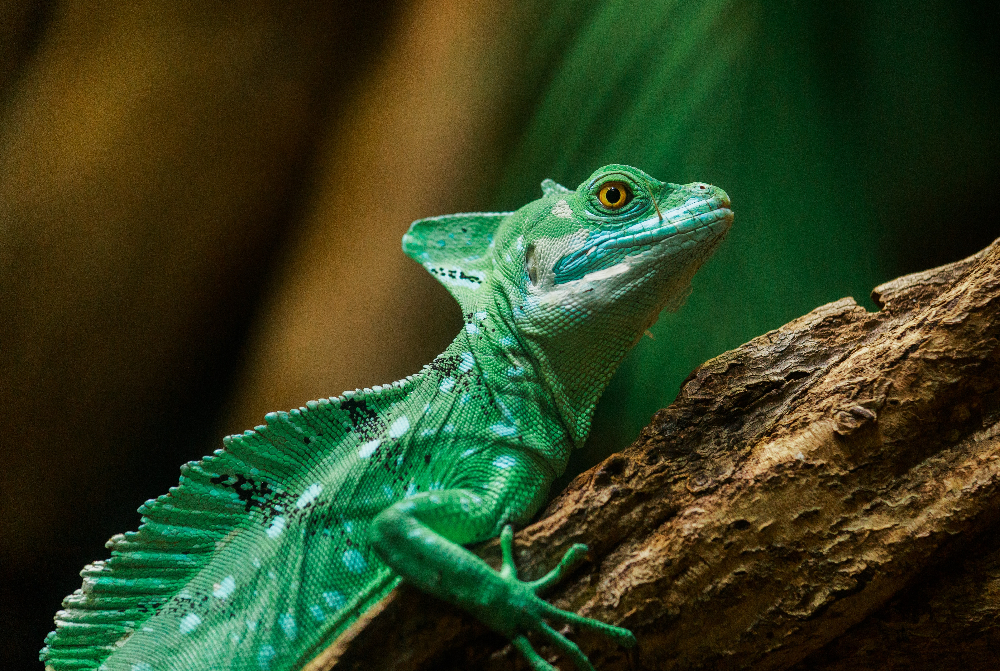
About TourHero
TourHero is a social travel platform that enables you to travel with like-minded people and fall in love with the journey. We work closely with handpicked local operators to ensure every experience curated is unique and exclusive to your travel group. Come with us on epic adventures and create memories that last a lifetime. Get started here!
